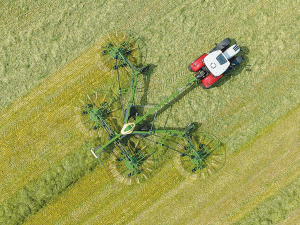Krone unveils new CombiPack HDP baler and halts US exports
Well-known for an extensive range of round balers, Krone’s new CombiPack HDP looks to have several features that sets it apart from its competitors.
 The Swadro TC1570 four-rotor centredelivery rake is said to be an ideal fit for highways in paddocks.
The Swadro TC1570 four-rotor centredelivery rake is said to be an ideal fit for highways in paddocks.
Controlled Traffic Farming (TCF) systems see arable operators, using tramlines as “highways” for moving through a crop.
Then, use machinery with specific operating widths to ensure there is no need to move off these tracks, thereby limiting compaction to the tramlines, rather than across the whole paddock.
While CTF has never really been used in dairy operations, German manufacturer Krone suggests this is changing as forward-thinking dairy farmers strive to limit compaction, particularly in wetter seasons.
The company suggests that with a maximum working width of 15.70m, the Swadro TC1570 four-rotor centredelivery rake is said to be an ideal fit for such operations.
Wider than the existing four-rotor TC1370, the V-frame concept on the newcomer is said to be an adapted version of the six-rotor TC2000.
Featuring 15 tine arms on each of the rotors, the mechanical driveline sees the front two rotors rotating about 25% faster than the rear units, which the company suggests promotes optimum forage flow through the machine to create tangle-free, box-shaped swaths. Operated via an ISObus terminal or in combination with an ISObus joystick, overall working width is adjusted by the two front rotor arms, while final swath wide of 1.40 to 2.90 metres is hydraulically adjusted via the rear pair of rotors.
The main frame can be lowered hydraulically to reduce the transport height to below 4.0m without the need to fold or remove any tine arms. The transport chassis is equipped with 710/40 R22.5 tyres as standard, or optional 800/35 R22.5 units, while infield stability is improved with the use of wide 16 x 9.50-8 tyres on the fourwheel rotor chassis’ and the 15/55-17 support wheels on the two front arms.
Electric height adjustment allows individual or simultaneous rotor adjustment, will the choice of two preselected heights to be saved on the terminal and activated at the touch of a button.
At headlands, the rotors can be set to lift just over existing swaths, while the lift delay of the rear rotors is also adjustable, and the automatic Soft- Down mechanism slows the speed of lowering just before the rotors touch down. Section control is also available to lift/lower the rotors automatically using GPS.
Legal controls on the movement of fruits and vegetables are now in place in Auckland’s Mt Roskill suburb, says Biosecurity New Zealand Commissioner North Mike Inglis.
Arable growers worried that some weeds in their crops may have developed herbicide resistance can now get the suspected plants tested for free.
Fruit growers and exporters are worried following the discovery of a male Queensland fruit fly in Auckland this week.
Dairy prices have jumped in the overnight Global Dairy Trade (GDT) auction, breaking a five-month negative streak.
Alliance Group chief executive Willie Wiese is leaving the company after three years in the role.
A booklet produced in 2025 by the Rotoiti 15 trust, Department of Conservation and Scion – now part of the Bioeconomy Science Institute – aims to help people identify insect pests and diseases.
President Donald Trump’s decision to impose tariffs on imports into the US is doing good things for global trade, according…
Seen a giant cheese roll rolling along Southland’s roads?